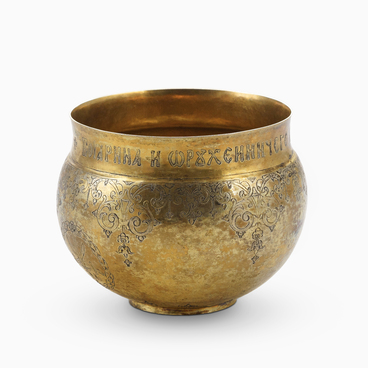Bratina
Creation period
the 17th century
Place of сreation
the Russian Empire
Dimensions
8,8x8x8 cm
Technique
silver; embossing, carving, gilding
Collection
Exhibition
3
Open in app#1
The museum houses cups called bratinas (from the Russian “brat”, meaning “brother”). There were cups for men and for women. The elegant golden bratina on display belonged to the second wife of boyar Bogdan Matveyevich Khitrovo — Maria Ivanovna, née Lvova, in her first marriage, Princess Buynosova-Rostovskaya.
People raised the so-called “health” cup when proclaiming a toast to the health of the sovereign: the prince (knyaz) or the tsar. The rite of the “health” cup probably dates back to pagan times. It was necessary to finish the drink in the “health” cup, because it was believed that whoever did not finish his drink wished something evil. As a sign that there was not a drop left in the cup, the drinkers tipped it over their heads. The custom of drinking to the sovereign’s health was widespread in Rus.
Bratinas were also used as memorial cups: they were filled with water sweetened with honey and placed on graves and tombs.
The first written mention of the bratinas dates back to the 16th century, but most of the surviving artifacts were produced later, in the 17th century. They were made of gold, silver, stone, bone, tin and even coconut, set in precious mounts. The surface of the body was decorated with embossed or engraved floral patterns, as well as with stamps, enamel, and a niello pattern depicting biblical scenes.
Bratinas featured inscriptions along the rim. The texts were different. Some immortalized the name of the owner of the bratina, others could capture the name of the person who presented the bratina as a gift. In general, more often than not, edifying quotes and instructions were written on the cups. For example, one of the bratinas of the 17th century featured the following inscription:
#3
This bratina of a good man, drink from it for your health, praising God, remembering His holy commandments recorded by the apostle Paul: brethren, do not get drunk on wine for it is sinful.
#4
On an 18th-century
wooden bratina, a different text was placed along the rim:
#2
My lords, stay, do not wait for the evening, do not get drunk.
#6
The bratina presented in the Museum of Russian Heritage is made of silver, but it is golden in color. Gilding is a process in which silver is coated with a thin layer of gold to protect it against corrosion and to imitate gold, which shines brightly and looks expensive.
#7
Bratina
#5
Ministry of Culture of the Russian Federation
read morehide
00:00
00:00
1x
Bratina
Creation period
the 17th century
Place of сreation
the Russian Empire
Dimensions
8,8x8x8 cm
Technique
silver; embossing, carving, gilding
Collection
Exhibition
3
Open in app
Share




